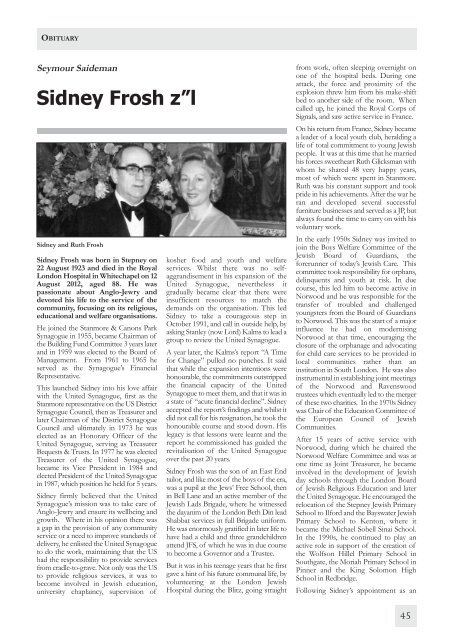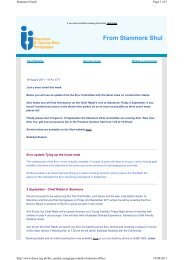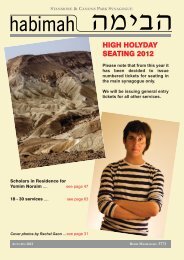STANMORE & CANONS PARK SYNAGOGUE - Stanmore and ...
STANMORE & CANONS PARK SYNAGOGUE - Stanmore and ...
STANMORE & CANONS PARK SYNAGOGUE - Stanmore and ...
Create successful ePaper yourself
Turn your PDF publications into a flip-book with our unique Google optimized e-Paper software.
OBITUARY<br />
Seymour Saideman<br />
Sidney Frosh z”l<br />
Sidney <strong>and</strong> Ruth Frosh<br />
Sidney Frosh was born in Stepney on<br />
22 August 1923 <strong>and</strong> died in the Royal<br />
London Hospital in Whitechapel on 12<br />
August 2012, aged 88. He was<br />
passionate about Anglo-Jewry <strong>and</strong><br />
devoted his life to the service of the<br />
community, focusing on its religious,<br />
educational <strong>and</strong> welfare organisations.<br />
He joined the <strong>Stanmore</strong> & Canons Park<br />
Synagogue in 1955, became Chairman of<br />
the Building Fund Committee 3 years later<br />
<strong>and</strong> in 1959 was elected to the Board of<br />
Management. From 1961 to 1965 he<br />
served as the Synagogue’s Financial<br />
Representative.<br />
This launched Sidney into his love affair<br />
with the United Synagogue, first as the<br />
<strong>Stanmore</strong> representative on the US District<br />
Synagogue Council, then as Treasurer <strong>and</strong><br />
later Chairman of the District Synagogue<br />
Council <strong>and</strong> ultimately in 1973 he was<br />
elected as an Honorary Officer of the<br />
United Synagogue, serving as Treasurer<br />
Bequests & Trusts. In 1977 he was elected<br />
Treasurer of the United Synagogue,<br />
became its Vice President in 1984 <strong>and</strong><br />
elected President of the United Synagogue<br />
in 1987, which position he held for 5 years.<br />
Sidney firmly believed that the United<br />
Synagogue’s mission was to take care of<br />
Anglo-Jewry <strong>and</strong> ensure its wellbeing <strong>and</strong><br />
growth. Where in his opinion there was<br />
a gap in the provision of any community<br />
service or a need to improve st<strong>and</strong>ards of<br />
delivery, he enlisted the United Synagogue<br />
to do the work, maintaining that the US<br />
had the responsibility to provide services<br />
from cradle-to-grave. Not only was the US<br />
to provide religious services, it was to<br />
become involved in Jewish education,<br />
university chaplaincy, supervision of<br />
kosher food <strong>and</strong> youth <strong>and</strong> welfare<br />
services. Whilst there was no selfaggr<strong>and</strong>isement<br />
in his expansion of the<br />
United Synagogue, nevertheless it<br />
gradually became clear that there were<br />
insufficient resources to match the<br />
dem<strong>and</strong>s on the organisation. This led<br />
Sidney to take a courageous step in<br />
October 1991, <strong>and</strong> call in outside help, by<br />
asking Stanley (now Lord) Kalms to lead a<br />
group to review the United Synagogue.<br />
A year later, the Kalms’s report “A Time<br />
for Change” pulled no punches. It said<br />
that while the expansion intentions were<br />
honourable, the commitments outstripped<br />
the financial capacity of the United<br />
Synagogue to meet them, <strong>and</strong> that it was in<br />
a state of “acute financial decline”. Sidney<br />
accepted the report’s findings <strong>and</strong> whilst it<br />
did not call for his resignation, he took the<br />
honourable course <strong>and</strong> stood down. His<br />
legacy is that lessons were learnt <strong>and</strong> the<br />
report he commissioned has guided the<br />
revitalisation of the United Synagogue<br />
over the past 20 years.<br />
Sidney Frosh was the son of an East End<br />
tailor, <strong>and</strong> like most of the boys of the era,<br />
was a pupil at the Jews’ Free School, then<br />
in Bell Lane <strong>and</strong> an active member of the<br />
Jewish Lads Brigade, where he witnessed<br />
the dayanim of the London Beth Din lead<br />
Shabbat services in full Brigade uniform.<br />
He was enormously gratified in later life to<br />
have had a child <strong>and</strong> three gr<strong>and</strong>children<br />
attend JFS, of which he was in due course<br />
to become a Governor <strong>and</strong> a Trustee.<br />
But it was in his teenage years that he first<br />
gave a hint of his future communal life, by<br />
volunteering at the London Jewish<br />
Hospital during the Blitz, going straight<br />
from work, often sleeping overnight on<br />
one of the hospital beds. During one<br />
attack, the force <strong>and</strong> proximity of the<br />
explosion threw him from his make-shift<br />
bed to another side of the room. When<br />
called up, he joined the Royal Corps of<br />
Signals, <strong>and</strong> saw active service in France.<br />
On his return from France, Sidney became<br />
a leader of a local youth club, heralding a<br />
life of total commitment to young Jewish<br />
people. It was at this time that he married<br />
his forces sweetheart Ruth Glicksman with<br />
whom he shared 48 very happy years,<br />
most of which were spent in <strong>Stanmore</strong>.<br />
Ruth was his constant support <strong>and</strong> took<br />
pride in his achievements. After the war he<br />
ran <strong>and</strong> developed several successful<br />
furniture businesses <strong>and</strong> served as a JP, but<br />
always found the time to carry on with his<br />
voluntary work.<br />
In the early 1950s Sidney was invited to<br />
join the Boys Welfare Committee of the<br />
Jewish Board of Guardians, the<br />
forerunner of today’s Jewish Care. This<br />
committee took responsibility for orphans,<br />
delinquents <strong>and</strong> youth at risk. In due<br />
course, this led him to become active in<br />
Norwood <strong>and</strong> he was responsible for the<br />
transfer of troubled <strong>and</strong> challenged<br />
youngsters from the Board of Guardians<br />
to Norwood. This was the start of a major<br />
influence he had on modernising<br />
Norwood at that time, encouraging the<br />
closure of the orphanage <strong>and</strong> advocating<br />
for child care services to be provided in<br />
local communities rather than an<br />
institution in South London. He was also<br />
instrumental in establishing joint meetings<br />
of the Norwood <strong>and</strong> Ravenswood<br />
trustees which eventually led to the merger<br />
of these two charities. In the 1970s Sidney<br />
was Chair of the Education Committee of<br />
the European Council of Jewish<br />
Communities.<br />
After 15 years of active service with<br />
Norwood, during which he chaired the<br />
Norwood Welfare Committee <strong>and</strong> was at<br />
one time as Joint Treasurer, he became<br />
involved in the development of Jewish<br />
day schools through the London Board<br />
of Jewish Religious Education <strong>and</strong> later<br />
the United Synagogue. He encouraged the<br />
relocation of the Stepney Jewish Primary<br />
School to Ilford <strong>and</strong> the Bayswater Jewish<br />
Primary School to Kenton, where it<br />
became the Michael Sobell Sinai School.<br />
In the 1990s, he continued to play an<br />
active role in support of the creation of<br />
the Wolfson Hillel Primary School in<br />
Southgate, the Moriah Primary School in<br />
Pinner <strong>and</strong> the King Solomon High<br />
School in Redbridge.<br />
Following Sidney’s appointment as an<br />
45





